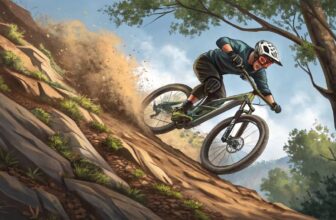Understanding Wheel Truing
Getting good at truing wheels is a game-changer for mountain bikers wanting their bikes to perform at their best. Here, you’ll see why it’s important and how to spot a wonky wheel.
Importance of Wheel Truing
Truing means adjusting your wheel spokes until it’s perfectly straight and round. Why bother? Because if it’s off, your mountain bike won’t ride smoothly. A well-trued wheel means no wobbling, safer rides, and fewer headaches down the trail.
Here’s why you should care about trying:
- Better Ride: A true wheel makes for smooth, even rides, getting every bit of power from your pedaling.
- Safety First: No wobbles means you’re in control, and less likely to experience spills.
- Longevity: Getting those spokes just right keeps your bike parts happier for longer.
Keeping your mountain bike in tip-top shape? Don’t skip the wheel truing. Dive into our mountain bike maintenance guide for more tips on staying trail-ready.
Signs of a Misaligned Wheel
Catching a bent wheel early can save you from a world of trouble and potential crashes. Here’s how to spot if things are starting to go sideways:
- Side-to-Side Wiggle: Noticing your rim swaying left or right? That’s sideways misery.
- Bumpy Rides: If the rim bobs up and down, you’ve got a bump up or down problem.
- Brake Rub: If your wheel rubs the brake pads here and there, it’s time for a fix.
- Weird Noises: Clicks or creaks could mean your spoke tension is all mixed up.
- Feeling Shaky?: Excessive vibes while you’re riding can be a major alert.
Check your wheels often if you ride gnarly trails or compete. It’ll save your skin (and your wallet) in the long run. For more repair advice, see our handling damaged rims guide.
By grasping why wheel truing is crucial and spotting misalignment signs, you’ll keep your mountain biking safe and fun. Want more nuggets of wisdom? Peek at our mtb suspension setup and best mtb tool kit articles for more good stuff.
Spoke Tension and Measurement
Getting the right spoke tension is like making sure your pizza’s crust isn’t too soggy or too crispy – it’s got to be just right! This part breaks down why keeping your wheels’ spokes tight is a big deal and how to get the tools you need to measure it without second-guessing.
Keeping Those Spokes in Check
Making sure your spokes aren’t playing loose and free is what keeps your mountain bike wheels ready to roll over roots and rocks without throwing a tantrum. Most rims have a sweet spot for tension, landing somewhere from 100 to 120 kilogram-force, or if you’re a Newtons nerd, that’s around 980 to 1177 of those.
Ignoring spoke tension can lead to wobbly wheels, which is about as fun as riding with a hitchhiking squirrel. Consistency is key; every spoke should be pulling its weight. If they’re too lax, give ’em a twist to tighten. Too tight? Unwind them a smidge.
Check out this handy tension cheat sheet:
| Tension (kgf) | Tension (N) |
|---|---|
| 100 | 980 |
| 110 | 1078 |
| 120 | 1177 |
Stick to these numbers, and you’ll keep those wheels spinning without a hitch.
Tools That Get the Job Done
When it comes to checking spoke tension, you need the right gear, or it’s like trying to win a burger-eating contest with chopsticks. Ditch the old “squeeze the spokes” trick for something more precise.
- Spoke Tensiometer: Gadgets like the Park Tool TM-1 are your best buds here. They clamp onto the spokes and let you know if they’re slacking or putting in overtime.
- Tension Guesswork: If you don’t have a tension meter handy, comparing your wheels to a well-tensioned set can help. Just remember, guessing isn’t always the best policy – this isn’t horseshoes or hand grenades.
Getting that tension just right keeps your bike from transforming into an unwieldy bucking bronco. And trust me, you’d rather focus on the trail instead of your tripping tire. For a boatload of other cool stuff like how to zip through rock gardens on your MTB crazy-fast or dial in your suspension settings like a pro, swing by our articles on mountain bike maintenance and more.
Process of Wheel Truing
Lateral Truing Process
Straightening that pesky side-to-side wobble makes any bike ride smoother and is a must-do for those of us with rim brakes. Get your wheels rolling right and enjoy a bump-free ride.
Steps for Lateral Truing:
- Spot the Wobble: Give your wheel a spin and mark where the side-to-side swings happen.
- Fiddle with Spokes: Get your spoke wrench ready. Tighten the spoke on the side where it wobbles too much and loosen the one opposite. This is all about balance, folks.
- Check and Check Again: Keep an eye on the wheel as you spin it. Make sure you’re actually fixing things.
- Go Again if Needed: Tweak until it’s steady as you go.
Pop that wheel on a truing stand for laser-like precision. A good spoke wrench and nipple tool are your friends here. Need more help? Check out our mountain bike maintenance guide.
Radial Truing Process
This is all about fixing the wheel’s roundness—no one likes a bumpy ride!
Steps for Radial Truing:
- Find Radial Bumps: Spin that bad boy and make a note of any ups and downs.
- Adjust Spokes: For bulges (high spots), tighten those spokes a bit. Give the low ones a lil’ bit of slack.
- Keep It Balanced: Don’t mess up the side-to-side harmony while you’re at it.
- Spin to Win: Give it another whirl to see if you’ve nailed it.
Radial truing can be tough for newbies since it’s easy to mess up side-to-side balance in the process. Aim for a smooth ride with less than a 1-millimeter hitch. A trusty truing stand will make things easier. For a deeper dive, take a peek at our diy mountain bike repairs.
| Truing Type | What it Fixes | Handy Tools |
|---|---|---|
| Lateral Truing | Side-to-side wobbles | Spoke wrench, Truing stand |
| Radial Truing | Up-and-down motion | Spoke wrench, Truing stand |
Know your wheels inside and out, and they’ll be more reliable on those gnarly trails. For more tips, drop by our pages on mtb tire pressure and mtb gear ratios.
Tools and Equipment for Wheel Truing
Alright, folks! If you’re itching to learn the fine art of whipping that mountain bike (MTB) wheels into shape, you gotta have the right gadgets and gizmos. In this part, we’ll chat about the must-haves like wheel truing stands and those nifty tools called spoke keys and nipple tools.
Wheel Truing Stands
These bad boys are your go-to for getting those MTB wheels in line. With a steady hand offered by wheel truing stands, your wheel balancing game will be on point. Now, brace yourself for the price surprise – these can run anywhere from a cool £80 up to a whopping £500 (BikeRadar).
| Feature | Basic Model | Advanced Model |
|---|---|---|
| Price Range | £80 – £150 | £300 – £500 |
| Tolerance | Just O.K. | Precision-packed |
| Extras | None | Bells and Whistles like Dial Indicators |
Fork over a few extra bucks, and you get tighter fixes and goodies like double caliper jaws and inbuilt dishing to boot!
Using this stand, you’ll spot any wheel wobbles easily and nip them in the bud. For weekend warriors, a basic stand does the trick. But hey, if you’re a pedaling pro, the snazzier models might tickle your fancy with their extra perks.
Spoke Keys and Nipple Tools
Now, let’s tighten the tension! Spoke keys and nipple tools are your trusty sidekicks here. They’re essential for giving that snug fit to the spokes. Depending on your spokes, you might need different tools. Classic ones come with handy flats for wrenching, while some mysterious types need a more specialized touch.
| Spoke Type | Adjustment Method | Tool Needed |
|---|---|---|
| Regular Joes | Wrench Flats | Standard Spoke Key |
| The Fancy Ones | From the Hub or Inside | Special Tools Only |
Make sure you’ve got the right spoke key size, or your nipples (the ones on wheels, of course) might end up worse for wear. For more nitty-gritty instructions, give Park Tool a peek.
Armed with the right gear, you’ll keep those MTB wheels spinning smoothly and keeping you upright. Fancy more tips on keeping your mountain beast in top shape? Swing by our guides for mountain bike maintenance, DIY mountain bike repairs, and mtb bearing replacement. Enjoy the ride!
Critical Aspects of Wheel Truing
Keeping that mountain bike rolling smoothly ain’t just about looking cool – it’s about knowing how to true those wheels like a pro. There’s a bit of magic in getting the spoke tension just right and making sure the wheel is nice and cozy between the frame’s arms.
Achieving Correct Spoke Tension
Spoke tension is like the secret sauce that keeps your wheels from acting up. You want it just right to stop all those annoying issues like wobbling, flexing, or even worse, a disastrous rim or spoke damage.
To measure that tension, grab yourself a handy gizmo like the Park Tool TM-1. Your wheel manufacturer should say how tight things should be, usually between 100 and 120 kilograms-force, or in geek talk, 980 to 1177 Newtons. It’s all about keeping things consistent across those spokes so your ride stays solid, not wobbly like a kid’s training wheels.
| Part | Tension (kgf / Newtons) |
|---|---|
| Spokes | 100 – 120 / 980 – 1177 |
Here’s how to get that tension spot on:
- Clean and lube those spoke nipples – makes life easier.
- Bust out your tension meter and give each spoke a check.
- Keep the tension even – don’t let one spoke flex like a bodybuilder!
Dishing and Alignment
Dishing, yep, that’s a fancy word for making sure the wheel’s smack dab in the middle between where it hangs from. If your wheel’s off-center, you’re gonna get wobbly bike steering and a messed-up vibe.
If your wheel’s pulling a stunt by being out of line, here’s what you do:
- Whip out a dishing tool flip the wheel in the frame, and check the gap from the rim to the frame on both sides.
- Turn those spokes – a little tweak here, a nudge there – till it’s sitting nice and centered.
There are two types of truth you gotta aim for:
- Lateral Trueness: No side-to-side jiggle, please.
- Radial Trueness: Keep it round like a pizza without the ups and downs.
Gabbin’ about wheels like this takes some patience and know-how. If you’re itching for more tips, we’ve got some cool tricks in our wheel truing stands and spoke keys guide that can help a ton.
Nail these key bits of wheel truing, and you’re looking at smoother roads, a better grip, and your bike hangin’ tough through those sunlit trails. Want to be even more of a bike guru? Check out our other guides on DIY mountain bike repairs and how to manual MTB.
Common Challenges in Wheel Truing
Getting the hang of truing your mountain bike wheel means tackling some familiar hurdles that can make this task a bit tricky. Two major headaches you might bump into are dealing with banged-up rims and juggling over-tightened spokes.
Handling Damaged Rims
One of the trickiest parts of wheel truing is when you’re faced with a rim that’s taken a beating. This kind of damage often happens when your wheel says “hello” to rocks or potholes in a less-than-gentle fashion. If the rim’s bent or cracked, just messing with the spokes probably won’t cut it. As mentioned by Park Tool, fixing a badly damaged rim might be a no-go, leaving replacement as the only option.
Steps to Assess Rim Damage:
- Visual Check: Look out for any visible bends, cracks, or dents.
- Touch and Feel: Run your hand along the rim to spot bumps or dents.
- Spin Test: Use a truing stand and spin the wheel to see if it wobbles.
Seeing serious damage? It’s often best to swap out the rim to keep your rides safe and smooth. Need more on keeping your mountain bike in shape? Visit our mountain bike maintenance page.
Dealing with Over-Tightened Spokes
Tweaking spokes too tight is another common snag that messes with truing. When the spokes are super tight, trying to fix one part of the wheel can lead to bigger issues elsewhere. Plus, these tight spokes make it more likely for the wheel to go wobbly after you try to fix it up.
Symptoms and Solutions:
- Off-kilter Curves: Fixing one side causes more bends elsewhere.
- Tension Troubles: Getting equal tension and a straight wheel can be tough on a low-grade or bent rim. Compromise might be the name of the game.
Suggested Approach:
- Use a Spoke Tension Meter: This nifty gadget helps keep tension even all around.
- Go Easy with Adjustments: Small tweaks mean you’re less likely to mess up other parts.
- Stress Monitoring: Letting out wheel stress keeps spoke tension in check.
| Common Issues | Symptoms | Tools Needed | Solutions |
|---|---|---|---|
| Damaged Rims | Visible bends or dents, uneven feel | Truing Stand, Visual Check | Rim replacement |
| Over-Tightened Spokes | Wobbles after fixes | Spoke Tension Meter | Small tweaks, stress patience |
Getting through these challenges is key to keeping your mountain bike wheels in fighting shape. For more info on related fixes, hop over to our pages on diy mountain bike repairs and mtb wheel truing.
Advanced Techniques in Wheel Truing
So, you’re diving into the nitty-gritty of wheel truing, huh? Buckle up and let’s get into the good stuff. We’re talking the heavyweights here—stress relief and keeping those spokes singing in harmony. Oh, and some golden nuggets on radial tightening.
Stress Relieving and Spoke Equality
When it comes to spoke tension and wheel longevity, balance is your best bud. Uneven spokes? Yeah, that’s like trying to ride a unicycle with a flat. Stress relieving, on the other hand, is your insurance against those stubborn wheel woes.
Spoke Tension Equality:
- Do your superhero tool belt with a tension meter, maybe the Park Tool TM-1. We’re talking precision here, folks.
- Keep your spokes in sync—imagine a choir where everyone’s singing the same tune. That’s the sweet spot of wheel truing.
- But hey, don’t go all Hercules here. Over-tightening can make your rims take on a mind of their own.
Stress Relieving:
- Give those spokes a little love. Think of squeezing out stress like a tension chiropractor.
- A dab of grease on those spoke nipples keeps things running smoother than butter on hot toast.
- Take your time, rinse, and repeat. A lil’ tighten, a lil’ squeeze—it’s like a dance.
Radial Truing Tips
Let’s get that rollercoaster wheel experience to chill. Radial truing is your no-nonsense fix for a wheel going boing-boing instead of vroom-vroom.
Initial Setup:
- Get that wheel in a truing stand—it’s like a spa day for your bike.
- Spin ‘er up, and keep an eye out for any high flyers or low riders.
- Sticky notes or zip-ties, use what you got to mark those wobblers.
Adjustments:
- If your wheel’s got a bulge, tighten the surrounding spokes like reining in a wild horse.
- If it’s like a pancake, slacken the nearby ties until it finds its shape.
- Baby steps, folks—don’t go cranking and busting bits. Change should be subtle.
Maintaining Balance:
- Once you tackle those peaks and valleys, go back to your spoke tension roll call.
- Keep at it until that wheel spins smoother than your grandma’s knitting yarn.
Tools and Checks:
- A solid spoke key is a must—think of it as a magic wand for riders.
- Test your work; angle that wheel like you’re showing off a piece of art.
| Radial Truing Steps | Action |
|---|---|
| High Spots | Tighten spokes around the bulge |
| Low Spots | Loosen spokes around the dip |
| After Adjustments | Recheck spoke tension & adjust |
Should you seek more pearls of wisdom on this two-wheeled adventure, swing by our piece on diy mountain bike repairs? Get the hang of these moves and your wheels will thank you, offering up a ride as smooth as your favorite jukebox tune.
Tips for Effective Wheel Truing
Keeping your mountain bike in top shape means getting your wheel truing just right. Wheel truing is fixing those wobbly wheels, so they spin smoothly without those annoying side-to-side or up-and-down shakes. Let’s swap some stories on how to get your wheels trued up like a pro.
Check Your Hub First
Don’t rush it! Before you even start with that wheel, make sure your hub’s not in a funk. A jiggly hub only makes everything else go wonky when you’re trying to true it. Get that hub just right, and you’re halfway there.
- Check if your hub bearings are rolling smoothly, with no hiccups or shakes.
- Tighten that hub, but stick to what the bike folks recommend.
- Listen up for any strange rubbing sounds as you spin the wheel — not normal.
Making the Most of Truing Stands
Shelling out for a truing stand? You could be looking at anywhere from a sweet deal of 80 quid to a whopping 500. The pricier ones are all about those tight tolerances and come decked out with fancy kits like dial doohickeys or dishing gadgets.
Here’s the lowdown on using your stand to nab that perfect wheel:
- Secure Your Wheel: Get it snug in the stand, all centered and locked tight.
- Tweak Those Guides: Your guides need to hover just off the rim, no touching!
- Spot the Wobble: Spin the wheel — look for those side-to-side wiggles or up-and-down jolts.
- Tiny Turns, Big Results: Grab a spoke key, and make those spoke tweaks — just a quarter turn each time — balance is the magic word here.
- Check and Recheck: After each tiny tweak, see how it’s swinging. Little by little is the name of the game.
| Tool | Price Range | What You Get |
|---|---|---|
| Basic Truing Stand | £80 – £150 | Handle basic adjustments |
| Intermediate Truing Stand | £150 – £300 | More detailed tweaking with some slick features |
| Professional Truing Stand | £300 – £500 | All the bells and whistles: dishing tools, precision gadgets |
Stick these tools and tricks in your mountain biking toolkit like a trusty sidekick. A hub that’s in check and a truing stand that’s your jam are your best friends for wheels that last longer and perform better. For more tidbits, peek at our other guides on MTB suspension setup and diy mountain bike repairs. They’re the kind of tips any bike lover needs on their ride.




